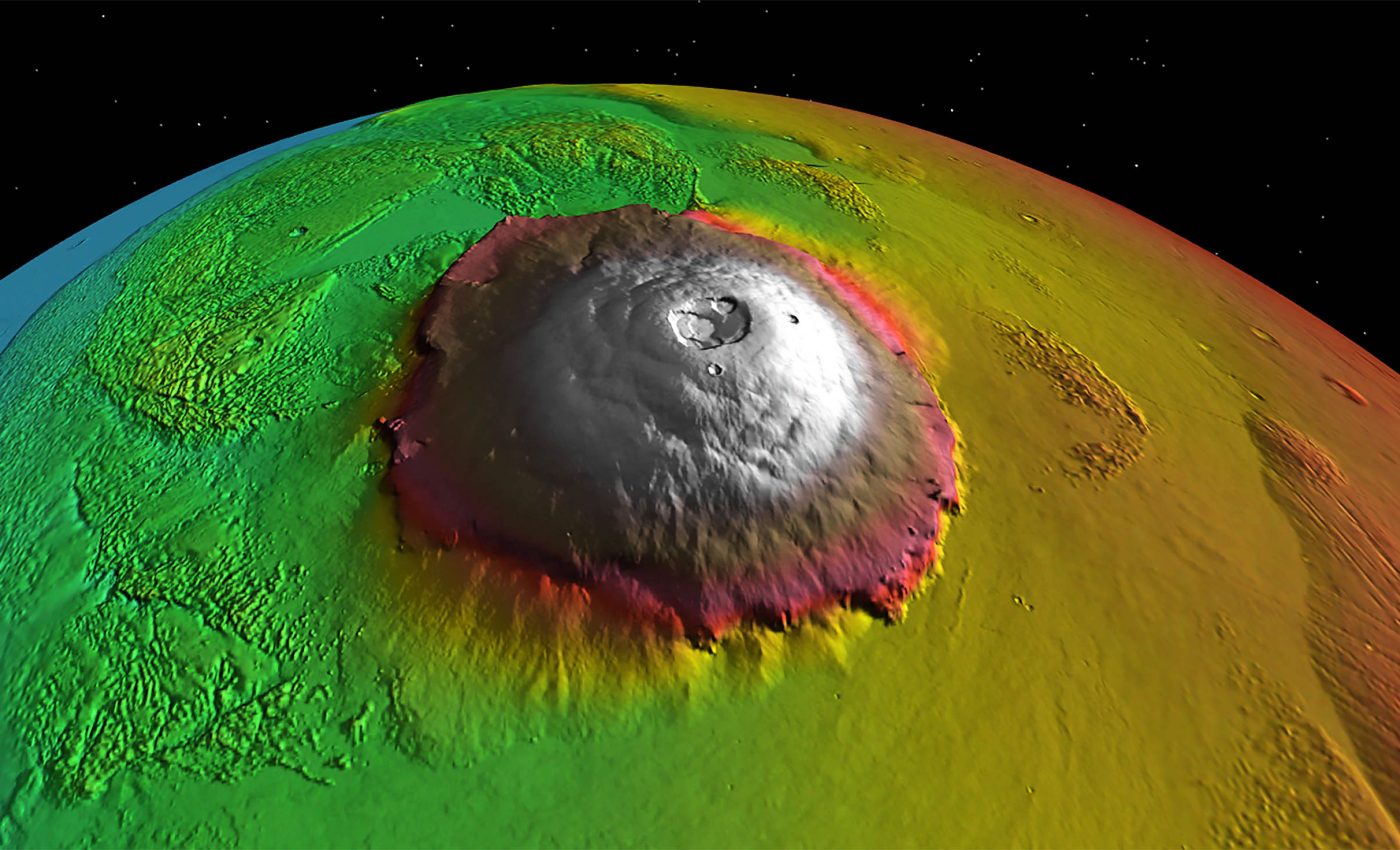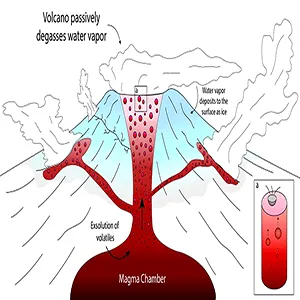
Volcanoes made it snow on Mars, burying ice near the equator
Mars’ warmest latitudes hide a paradox: thick, buried ice where midday temperatures can reach a balmy 68°F (20°C). After years of study, planetary scientists believe they finally know how those equatorial ice sheets formed.
The culprit, they argue, wasn’t a slow shift in climate over eons but a cataclysmic burst of volcanism.
This burst lofted water from the planet’s interior into a thicker, ancient atmosphere, where it froze, fell as snow, and became entombed beneath dust.
If that story holds, it doesn’t just solve a Martian mystery – it also points to a valuable resource for future astronauts.
Mars’ equator hides buried ice
Mars is famously rich in ice, but most of it sits where you’d expect – at the poles. Over the past decade, however, orbital radar has revealed sprawling, high-latitude-like ice deposits lurking near the equator.
It’s a strange discovery, since the equatorial band receives the most sunlight and is, on average, the warmest region on the planet.
“Volcanic eruptions are often seen as destructive forces, but on Mars they may have triggered precipitation events that helped create conditions where water – and perhaps life – could once exist,” explained Saira Hamid from Arizona State University.
In other words, Mars appears to be storing winter in its tropics.
Explosive origins of tropical glaciers
Hamid and her colleagues approached the paradox with a simple question: could Mars make its own snow in the tropics, even long after its primordial oceans vanished? Their simulations say yes, but only if you add volcanoes.
The experts modeled a sequence of explosive eruptions billions of years ago, when Mars had a much denser atmosphere than it does today.
Those blasts would have thrust ash, sulfur gases, and, crucially, water from the planet’s interior high into the sky.
At altitude, water vapor cools and condenses. On ancient Mars, the team argues, it would have frozen and fallen out as snow, blanketing the surface in layers that later compacted into ice.
The volcanic “fire” injects water. The cold upper atmosphere turns that water to snow. And the result is ice – right where thermodynamics would otherwise suggest it shouldn’t survive.
Eruptions on a different scale
On Earth, even the largest eruptions are constrained by gravity and a thick, oxygen-rich atmosphere.
Mars plays by different rules. With lower gravity and, in the distant past, a denser but compositionally distinct atmosphere, eruption plumes could reach extraordinary heights, up to 40 miles (65 kilometers) or more.
Some simulations even allow material to be lofted to the edge of space. That kind of vertical reach would have spread icy particles over vast distances, making planet-scale “snow events” plausible after each pulse of volcanism.
“By studying these young effusive eruptions, we’re seeing how even relatively recent volcanic activity could have dramatically reshaped Mars’ surface and atmosphere,” Hamid continued.
“It’s fascinating to think that a single eruption could create atmospheric warming, only to plunge Mars back into a deep freeze soon after.”

Volcanic ash trapped ancient snow
Ice doesn’t last long on the surface of modern Mars. Under today’s thin atmosphere, it tends to sublimate, especially in sunny, low-latitude regions.
The new model accounts for that by adding a key ingredient: ash. When the volcanic plumes collapsed, they didn’t just seed snow. They also sprinkled the ground with fine dust.
That ash settles atop the accumulating ice like a thermal blanket, insulating it from daily heating and slowing the escape of water molecules to the atmosphere.
Over millions of years, this “dirty ice” layer could persist underground, protected by its own preservative crust.
The scenario dovetails with one of Mars’s strangest geological provinces: the Medusa Fossae Formation, a massive swath of friable, wind-sculpted deposits near the equator.
Radar hints that Medusa Fossae conceals immense amounts of ice – enough, by some estimates, to fill the Great Lakes if fully melted.
A volcanic snow origin elegantly explains both the formation’s volume and its dusty, layered character.
Mars’s tilt can’t explain all
For years, researchers leaned on Mars’s chaotic obliquity – its axial tilt – to explain low-latitude ice. The planet wobbles far more than Earth does, and its poles and tropics trade places in terms of sunlight over geologic time.
Under that view, today’s tropical ice is yesterday’s polar cap, stranded after the climate shifted. The new simulations don’t rule out tilt-driven migration, but they make it unnecessary.
Volcanic ice could sustain missions
Equatorial regions are prime real estate for landers. The atmosphere, thin as it is, provides its most useful braking effect there, and sunlight is plentiful for solar power.
If thick ice truly lies just beneath the surface, that’s a game-changer: water for drinking, oxygen production, and fuel manufacturing could be in the neighborhood of the safest landing zones.
However, caution is warranted, Watters noted that no one should stake a crew’s survival on a radar trace alone.
Looking for ash in ice
The volcanic snow hypothesis makes testable predictions. Ice layers should be interbedded with ash and sulfur-bearing minerals. Their chemistry might carry a fingerprint of volcanic gases.
The thickness and distribution of deposits should mirror where ancient eruption plumes would have drifted.
Upcoming radar passes, thermal mapping, and, eventually, shallow drilling could look for those signatures.
If robotic scouts can sample an equatorial ice lens and find volcanic ash mixed through it, the “fire and ice” origin will look much more secure.
Fire and ice define Mars
The broader implication is a Mars that stayed active – and watery in its own way – longer than a simple “cold desert” tale allows.
Even after surface rivers dwindled, the planet’s interior could have puffed water skyward in pulses, building hidden reservoirs that survive today.
That reframes how we think about past habitability in the tropics and about the practical logistics of living off the land there in the future.
“These findings shift our view of how and where ice could have formed on Mars,” Hamid concluded. “They show that volcanic activity may have created and preserved water-rich environments far from the poles – possibly for billions of years.”
Ancient eruptions may have done far more than sculpt mesas and plains; they may also have stocked the hottest parts of Mars with buried ice.
For scientists, that resolves a lingering contradiction. For explorers, it reads like an invitation – one that comes with a sensible proviso: bring the instruments, bring the drills, and yes, at least for the first missions, bring some water, too.
The study is published in the journal Nature Communications.
—–
Like what you read? Subscribe to our newsletter for engaging articles, exclusive content, and the latest updates.
Check us out on EarthSnap, a free app brought to you by Eric Ralls and Earth.com.
—–













